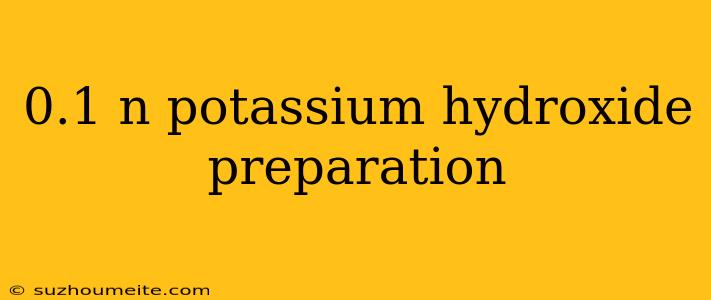0.1 N Potassium Hydroxide Preparation
Introduction
Potassium hydroxide (KOH) is a strong base commonly used in various laboratory applications, such as titration, pH adjustment, and sample preparation. A 0.1 N potassium hydroxide solution is a critical reagent in many analytical procedures. In this article, we will discuss the preparation of 0.1 N potassium hydroxide solution.
Materials
- Potassium hydroxide (KOH) pellets
- Distilled water
- A weighing balance
- A 1 L volumetric flask
- A stir plate and stir bar (optional)
Preparation of 0.1 N Potassium Hydroxide Solution
Step 1: Calculate the Amount of KOH Required
The normality of a solution is defined as the number of equivalents of solute per liter of solution. To prepare a 0.1 N potassium hydroxide solution, we need to calculate the amount of KOH required.
The molecular weight of KOH is 56.11 g/mol. Since potassium hydroxide is a strong base, its equivalent weight is equal to its molecular weight. Therefore, the equivalent weight of KOH is 56.11 g/equivalent.
To prepare a 0.1 N solution, we need to add 0.1 equivalents of KOH per liter of solution. The amount of KOH required can be calculated as follows:
Amount of KOH (g) = Normality x Equivalent weight x Volume (L) = 0.1 x 56.11 x 1 = 5.611 g
Step 2: Weigh the KOH Pellets
Using a weighing balance, accurately weigh 5.611 g of potassium hydroxide pellets.
Step 3: Dissolve the KOH Pellets
Transfer the weighed KOH pellets to a 1 L volumetric flask. Add a small amount of distilled water to the flask and stir until the KOH pellets are completely dissolved. This can be done using a stir plate and stir bar, if available.
Step 4: Dilute the Solution to Volume
Once the KOH pellets are fully dissolved, add distilled water to the flask until the volume reaches 1 L. Mix the solution well to ensure homogeneity.
Step 5: Verify the Normality (Optional)
To verify the normality of the prepared solution, you can perform a titration against a primary standard acid, such as potassium hydrogen phthalate (KHP).
Precautions
- Handle potassium hydroxide with caution, as it is a strong base and can cause skin and eye irritation.
- Wear protective gloves, goggles, and a laboratory coat when handling KOH.
- Prepare the solution in a well-ventilated area to avoid inhalation of KOH fumes.
Conclusion
A 0.1 N potassium hydroxide solution is a critical reagent in various laboratory applications. By following the steps outlined in this article, you can prepare a 0.1 N KOH solution accurately and safely. Remember to handle KOH with caution and verify the normality of the solution using titration, if necessary.
